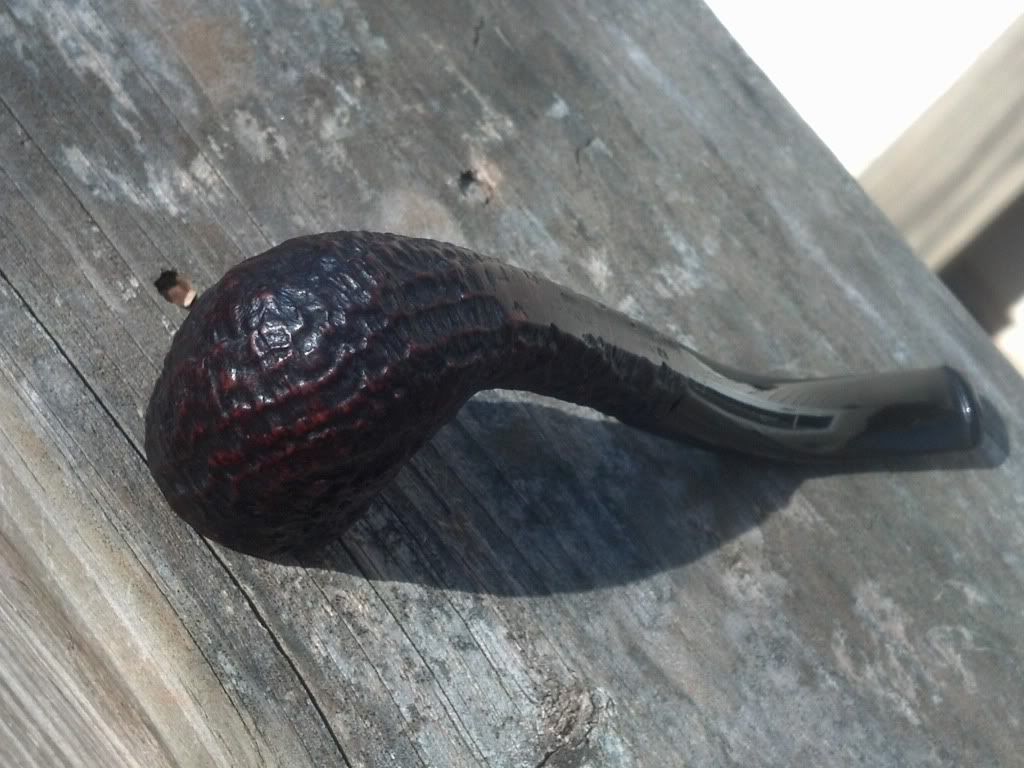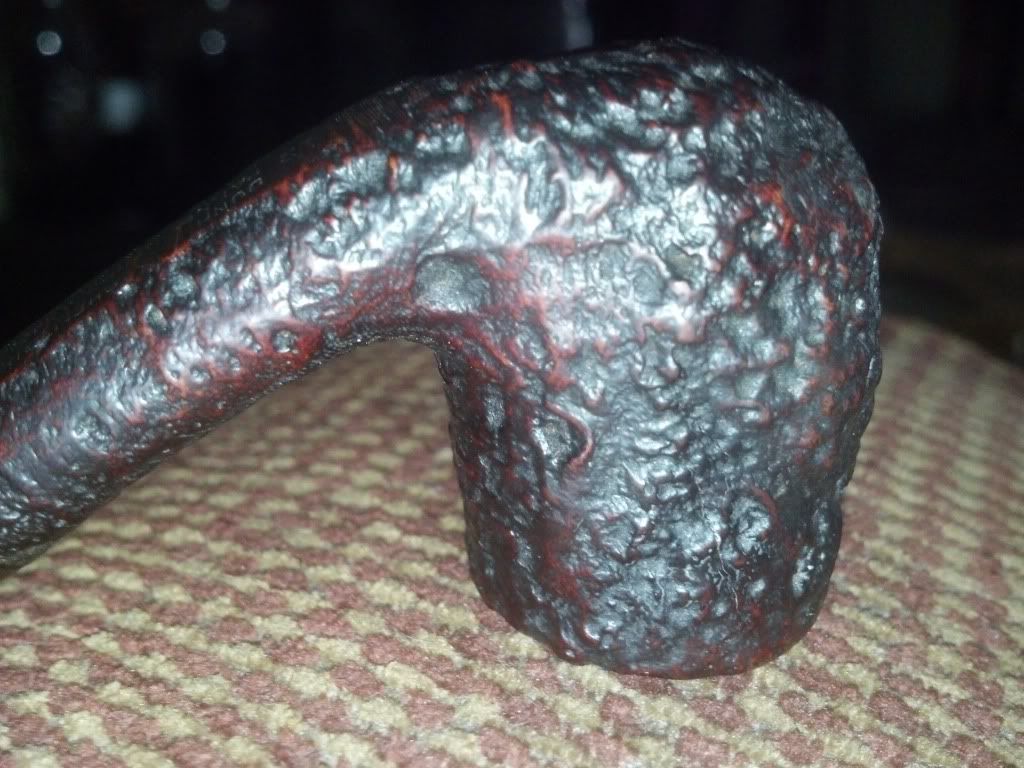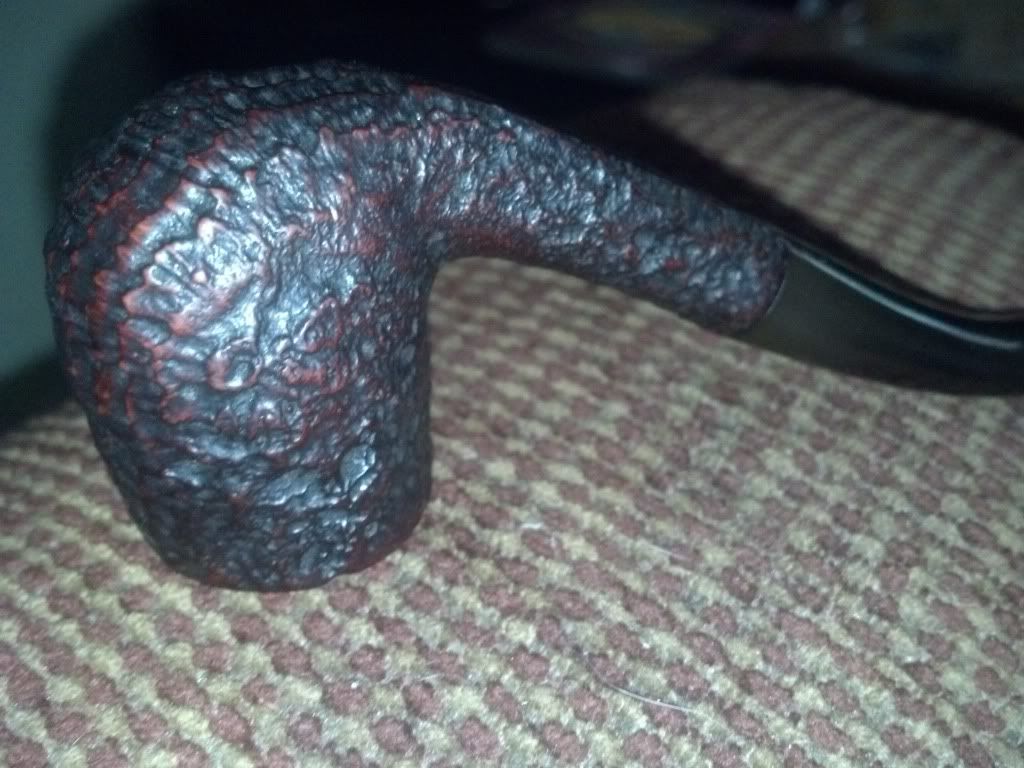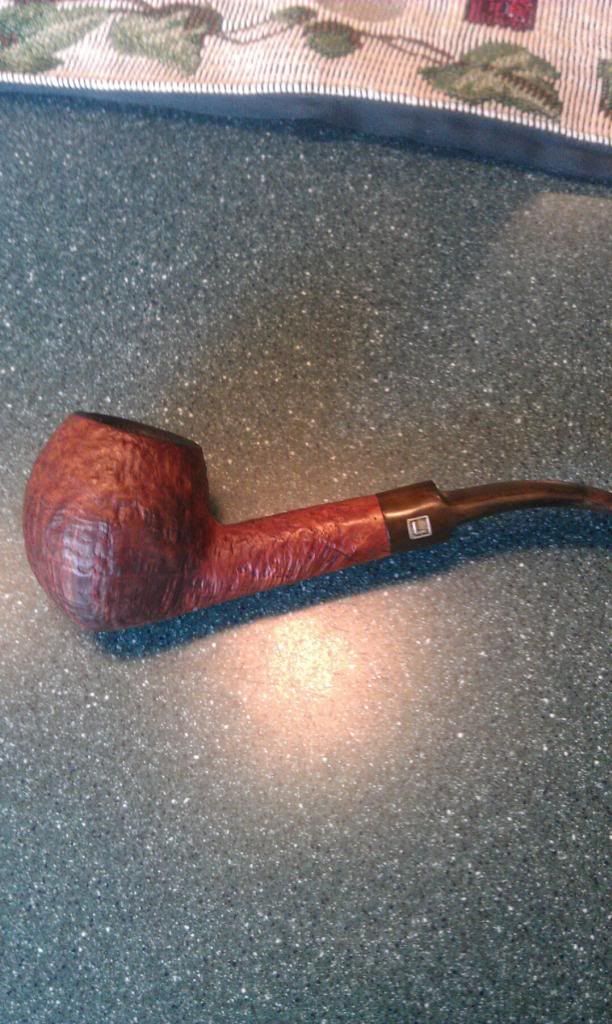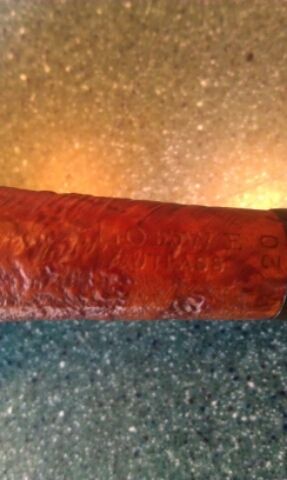






The early history of the sandblasted pipe remains pretty fuzzy, but the general thought among most collectors is that its origin dates to 1917 with Alfred Dunhill -
- although there is some dissent on the topic, most notably from ebay seller Mr. Can, who has stated:
"First, as a historical note, be sure to note that this YELLO-BOLE is SANDBLASTED!!! And, it was made between 1932 and 1935. Now, how do you suppose that could happen since Alfred Dunhill applied for his United States Patent for sandblasting in 1918 and it was granted by the United States Patent Office in 1920 (Patent Number 1341418/20). The Patent should preclude other pipe companies from sandblasting pipes for a minimum of 20 years - - - but in less than 15 years this YELLO-BOLE was sandblasted! What that tells you is that KB&B was sandblasting PRIOR TO Alfred Dunhill "inventing" and patenting the sandblasting process!!! In common language, KB&B was "grandfathered" (but obviously did nothing to stop Dunhill from obtaining a patent)! (Note: The same applied to Barling in England which continued sandblasting their "Fossils" even after Dunhill obtained its patent!)"
http://www.ebay.com/itm/ULTRA-RARE-1932-35-KB-B-YELLO-BOLE-SANDBLASTED-SHANK-LOGO-DOUBLE-LOGO-PRISTINE-/351051501587?pt=LH_DefaultDomain_0&hash=item51bc4cd013&nma=true&si=iNUuQ9Nj0ALWwJI9dhbbBNfXKmw%253D&orig_cvip=true&rt=nc&_trksid=p2047675.l2557

...and he said this regarding Barling:
Indeed, KBB was very early in adopting the sandblasted finish with the Thorn, and they were some damn fine examples for sure..."The "SHELL" or "SHELL BRIAR" SANDBLASTED Finish is one of Dunhill's original finishes giving rise to many of the early Dunhill Patents. Although Barling originated the sandblasting process for pipes (on their "Fossils") they did not patent the process. So, Alfred Dunhill (who was never shy about copying what had been successful for his competition including the Vauen dot for the Dunhill White Spot, Comoy's oversize 800 Series for the Dunhill ODA's, and so on) went ahead and patented the sandblasting process. The early sandblasts were deep and furrowed while later ones were more shallow (probably because of the briar used rather than a difference in the process itself)."




...and their great tradition of quality blasts carried on for a long time, continued with the Relief Grain.
Here's another Yello Bole:



And somewhat related would be WDC -




It's difficult to sort out, but if we accept that Dunhill was first, who then was second, and third, and so forth? I'd be interested to know just for historys sake.
In his 1922 bookTobaccoland, Carl Avery Werner gives us this:
That's pretty early in the scheme of things and I think gives a clue that there were more makes than just Dunhill at that early stage doing the blasts."Shell briars, sometimes called relief briars, are those the bowls of which have irregular corrugations on their outer surface, like a walnut shell. This effect is obtained by a sandblasting process which grinds out the soft veins of the wood, throwing the harder veins in relief."
In fact, on page 25 of this 1922 Civic catalog, you will see the Rock pipe, hard grain shrunk bruyere root, and the blast quality looks great!
http://pipeacademy.org/pdf/working_groups/Civic%20Company%201922%20Trade%20List.pdf
...early catalogs like this are invaluable to document the facts of the matter, but the printed matter is scarce.

I own this early blasted bulldog and I love its weathered beaten appearance, but the nomenclature is so worn that I'll never really know who made it.
It's extraordinarily difficult to date pipes in many cases - even when they happen to have silver hallmarks, this old horn-stemmed Hardcastle looks like the same pipe to me, sold a few years apart, yet I'm unsure because of the specs, what do you think?
http://www.smokingpipes.com/pipes/estate/england/moreinfo.cfm?product_id=50328
http://www.smokingpipes.com/pipes/estate/england/moreinfo.cfm?product_id=77303



Got to have a few early Shells here, just so beautiful...






Here's an early Parker, a 1925 Super Briar Bark:




This is a Weingott pipe, reported to be circa 1935:

...some of the more obscure makers like this will remain a mystery it seems, like Maurice and others.
Here's a very interesting Loewe, a scarce example because they didn't seem to produce many blasts, and this one looks early because of the oddly placed cartouche:



Here's what appears to be an early GBD Prehistoric, the stem is stamped "hand cut", does that help pinpoint a date?


A total mystery to me is a maker named Depi, but it looks to be an early example and the finish is quite gnarly - it might've even been rusticated first then blasted?


...and another Depi

Here's an early Comoy's Tradition, at what date did they start blasting?



And now, the famous Barling Fossil, at what date did they begin blasting?








Any maker I'm missing that may help us determine the who and when of early sandblasting?
Sasieni was late to the game, I'll speculate that the Ruff Root wasn't available until postwar, I could be wrong though, can anyone point to an early example?
The Rustic finish often looks great, and seems to try and emulate a blast finish...


...but even when well-done, here by a talented carver from Ukraine,

...a rusticated simulation just doesn't really quite capture the chaotic natural magic.
This overview of sandblasting by R.D. Field is a good primer:
http://www.rdfield.com/Articles/The%20Art%20of%20the%20....htm
And I love this article by Trever Talbert:
http://pipedia.org/wiki/How_to_Read_your_Sandblast
And this blog post by N.A.R.:
http://www.apassionforpipes.com/neills-blog/2010/9/23/what-a-blast.html
Also of interest,
Click the pop-up image for Black Diamond, the frontal shot gives a great view of the blast gun pattern in concentric rings, quite interesting. I'd say the pipe is from the late 40's to early 50's.
http://pipephil.eu/logos/en/dots/do-1dot.html
Just for reference, here's a list of sandblast names:
ANCIENT BRUYERE - Medico
ANTIQUE - diverse makers
AULD ERIN - Peterson 2nd (name used for both blast and rusticated finishes)
AX - Orlik (prefix in front of shape # on Old Bond Street grade)
BARBIC - Bartlett & Bickley (name used for both blast and rusticated finishes)
BARK - Ferndown
BARK GRAIN - Colossals
BATR - Karsten Tarp
BLACK PEARL - Jobey
BLACKRUF - Iwan Ries
BLACKTHORNE - Weber
BOLDERGRAIN - BBB
BRIARBARK - Parker
BRINDLE - Ashton
BURL GRAIN - Old Vic
BURLEY GRAIN - Civic
CAP BLANC - Chapuis Comoy
CHALLENGER - BB&S
CHAMPION - Blakemar
CHINOOK - Brigham
COLLECTOR - Jamesons
COMMODORE - Dr. Grabow
CORAL GRAIN - Ben Wade
CORTINA - Barontini
COUNTY - Dunhill
COUNTRYMAN - Tanganyika and Duncan
CRAGMOOR - Britannia
CRUSTED - BBB
CRUSTY BRIAR - Astley's (catalog notation, unsure if any pipes were actually stamped this way)
CUMBERLAND - Dunhill
CURLYNOB - Krinton
CUTLESS - Loewe (French made)
DANISH PRIDE - Ben Wade (Preben Holm)
DEEP SHELL - Dunhill
DELUXE - diverse makers
DOUBLE SAND - Orlik
DRAGOON - Britannia
DRIFTWOOD - Wallenstein (unsure if SB'd, but cool nonetheless!)
ENGLISH OVATION - Ben Wade
ENGLISH ROUGH - Fader's
ENGLISH RUSTIC - Tinder Box
FANTASY - GBD
FIELD GRAIN - Marshall Field
FOSSIL - Barling's Make
FRIAR - Jody Davis
FROG - Michael Lindner's highest grade sandblast (magnum only)
GOLDEN BARK - Parker and late Comoy's
GOLDEN DANISH - Stanwell and Preben Holm
GOLDEN ROUGH - Civic
GRANA - Rossi
GRANITAN - GBD
IMPERIA - Lorenzo
KAPRIES - Peterson
KAPRUF - Peterson
KERLYBRIAR - WDC
KING'S IMPERIAL - Blakemar
KNOBBY - Finlay's
LITESHELL - Premier
LUMBERJACK - Lloyds (Lorenzo 2nd)
LX - Orlik (prefix in front of shape # on Supreme grade)
NOBBY - BB&S
NO-WEIGHT - Parker
NUGGET BRIAR - Wally Frank
OGF - J.T. Cooke
OKF - J.T. Cooke
OLD ANTIQUARI - Castello
OLD BRIAR - diverse makers
OLD CHURCH - Ashton
OLD ENGLISH - Loewe
OMEGA - Alpha
OYSTER - Copley's
PEBBLE GRAIN - Ashton and Comoy's
PEBBLE SHELL - Ashton
PREHISTORIC - GBD
REDBARK - Dunhill
REGULAR - Don
RELIEF - Charatan and probably others
RELIEF GRAIN - Kaywoodie
RING GRAIN - Dunhill
RIPPLE - Smokecraft
RIPPLE GRAIN - BBB, Loewe, and Tinder Box
ROXBRIAR - Bomage & Hawkings
ROCK BRUYERE - Civic
RUBYBARK - Dunhill
RUFF ROOT - Sasieni
RUSTIC GRAIN - Heritage
SABBAITE - Barontini
SABBIA - Paul Bonacquisti
SABBIA ORO - Ascorti
SABBIATA - diverse Italian marques
SABLÉE - GBD and Anselmi and misc. French makers
SAHARA - Rinaldo
SANDBLAST - Comoy's amongst many others
SANDBLASTED BRIAR - L. Roux
SAND-CARVED - Delacour Bros.
SANDFLAME - Pino
SAND-GNARL - ? unknown maker
SANDGRAIN - Royal Dutch
SANDHEWN - Hardcastle
SANDROC - Cellini and Erica
SANDY - Delpi
SANGRAIN - Imperial
SANS ÉGAL - Fribourg & Treyer
SCOTCH GRAIN - Weber
SCULPTURA - Dr. Grabow
SHELL - Dunhill
SHELLCRAFT - Kaywoodie
SHELLED BRIAR - Black Diamond
SHELLMOOR - Jobey
SHILLING GRAIN - Dunhill
SILK CUT - Radice
SILVER CLOUD - Comoy's
SNIGGE - Karsten Tarp
SPECIAL - diverse makers
SPECIMEN GRAIN - ? unknown maker
SPIDER - Michael Linder (highest grade)
SUEDE BLAST - Walt Cannoy
SUPER - diverse makers
TANSHELL - Dunhill
TANTHORNE - Weber
TAPESTRY - GBD
THORN - Kaywoodie and Yello-Bole
THORNEYCROFT - BBB
TOBY SHELL - Druid Pipe Works Ltd.
TURTLE - Dal Fiume
TX - Orlik (prefix in front of shape # on De Luxe grade)
URANO - Ardor
VARIO - Stanwell
VINTAGE - diverse makers
VINTAGE CLASSIC - Michael Butera
X-TRA - Amphora and Douwe Egberts
...some of those oldies are exceedingly difficult to find, like the Toby Shell by Druid Pipe works, has anyone ever actually seen one?!?!?
I try to pick up the oddball scarce specimens whenever I come across a good one, I was lucky to find a great WDC Kerly Briar, and just recently found an Imperial Sangrain:

...and an old Orlik Double Sand is on the way too.
Any input, opinion, advice, knowledge, or general response on this topic overall would be most appreciated.
Thank you.
:puffpipe:









